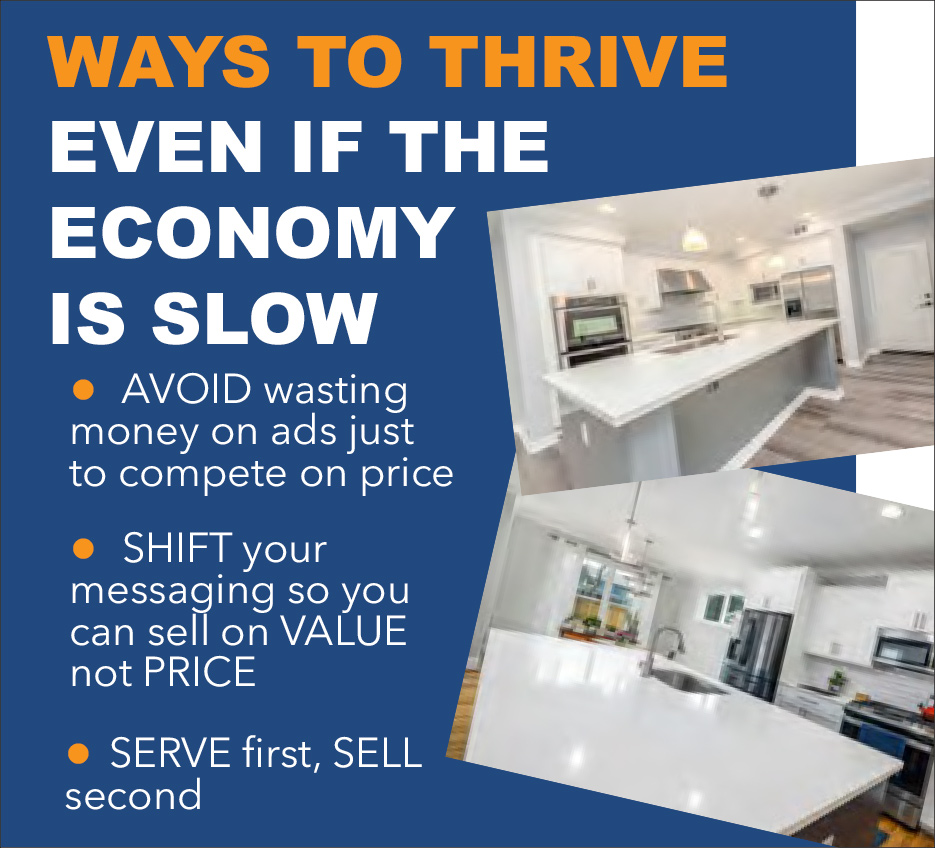Thriving in a Challenging Economy: How to Strengthen Your Marketing Sales and Strategies
Ed Young
Fabricator’s Coach
 As the dreaded economic slowdown affects more fabrication shops each day, it’s clear that relying on old strategies won’t cut it anymore. To navigate these challenging times successfully, you need a solid marketing plan that doesn’t rely on lowering prices to generate leads, and you need effective sales techniques to convert those leads into bookings. Here’s how you can adapt and rise above the competition.
As the dreaded economic slowdown affects more fabrication shops each day, it’s clear that relying on old strategies won’t cut it anymore. To navigate these challenging times successfully, you need a solid marketing plan that doesn’t rely on lowering prices to generate leads, and you need effective sales techniques to convert those leads into bookings. Here’s how you can adapt and rise above the competition.
Stop “Marketing by Accident” and Start “Marketing on Purpose”
The goal of marketing is simple: generate leads—prospective customers that your sales team can convert into paying clients. But here’s the catch: if your marketing is focused on your latest discounts, new colors, or pictures of recent installations, you’re positioning yourself as just another shop among many. You’re not giving your customers any reason to consider you beyond price or variety.
Don’t believe it? Try pulling up the websites or Facebook pages of 10 different fabrication shops. After looking at three, you’ll see that they all start to look the same.
Most fabricators fall into the trap of copying what others are doing. This includes playing the “low price game.” If you’re not careful, you might be doing the same thing. So, how do you avoid wasting money on ads just to compete on price?
Understand Your Customer’s Perspective
To stand out, start by stepping into your customer’s shoes. Look at the world from their perspective, and craft your marketing message to reflect their concerns. When you do this, you become much more than just another option—you become a trusted partner.
Begin by identifying the problems that keep your customers up at night. If your primary customer is a contractor, tailor your message to show that you understand their challenges. If you primarily serve homeowners, adjust your messaging accordingly.
For example, contractors are worried about hitting deadlines and managing multiple projects. Homeowners, on the other hand, are focused on selecting the perfect product that fits their vision and budget. While there’s overlap, their core concerns differ.
Five Insights on How to Sell Without Being “Salesy”
Even with excellent marketing that brings in high-quality leads, you still need to convert those leads into actual sales. The challenge is that no one likes being “sold to.” So, how do you sell without coming off as pushy?
The answer lies in changing your perspective and approach. Here are five key insights on how to sell without selling:
1. Understand Why Buyers Buy
People don’t buy products or services—they buy solutions to their problems. Whether they’re trying to relieve a pain point, reduce fear, or achieve a goal, purchases are driven by emotion. Buyers make emotional decisions and then justify them with logic.
If you only ask surface-level questions, you won’t uncover the real reasons behind a customer’s purchase decision. Connect on an emotional level by understanding their deeper motivations. Customers want to work with someone who understands their unique situation and can guide them toward the best solution.
2. Focus on Helping, Not Selling
Sales shouldn’t feel like sales. Your role is to serve by helping prospects find the best solution for their needs. When you shift the conversation from selling to solving, the value of what you offer becomes more apparent.
3. Create Interest, Not Resistance
Every interaction you have with a potential customer either generates interest or creates resistance. Your mindset plays a huge role here. If your primary focus is “How can I get this person to buy?” you may be pushing customers away.
Instead, focus on truly helping your prospects. When you approach each conversation with the goal of serving their needs, you’ll build stronger connections and gain more clients.
4. Ask Provocative Questions
Exceptional salespeople challenge prospects to think differently. By asking thoughtful, provocative questions, you help them reframe their current situation. This approach provides value to the customer and helps you better understand their needs.
Asking the right questions allows you and the prospect to jointly uncover the best path forward. This not only builds trust but also helps you identify if your solution is the right fit.
5. Master the M3 Formula: Mindset, Mechanics, Motion
Success in sales requires a strong foundation in three areas: Mindset, Mechanics, and Motion.
- Mindset: A positive, proactive mindset is critical to long-term success. Understand what drives your perceptions and reactions.
- Mechanics: This refers to the specific skills and processes you need to succeed in sales. Being prepared for any situation will help you close more deals.
- Motion: Consistency is key. You need to maintain constant, intelligent action. Set clear goals, create a plan, and stick to it, adapting as needed.
By mastering these three elements, you can ensure steady, reliable results.
The Takeaway: Serve First Sell Second
At the end of the day, customers don’t just want a product—they want a trusted advisor who can guide them toward the best decision for their unique needs. A solid marketing strategy will generate a steady flow of leads, but without effective sales techniques, those leads won’t convert.
By focusing on serving your prospects and shifting away from the “low price game,” you can build a more profitable, sustainable business, even in tough economic times.
It’s possible to grow your business, make money, and still have time to enjoy your success.
For further insights or a more tailored approach to your business, feel free to reach out to the author at Ed@FabricatorsCoach.com.